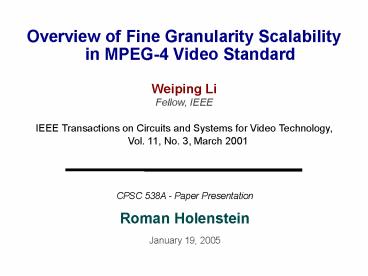Overview of Fine Granularity Scalability in MPEG-4 Video Standard PowerPoint PPT Presentation
Title: Overview of Fine Granularity Scalability in MPEG-4 Video Standard
1
Overview of Fine Granularity Scalability in
MPEG-4 Video Standard
Weiping Li Fellow, IEEE IEEE Transactions on
Circuits and Systems for Video Technology, Vol.
11, No. 3, March 2001
CPSC 538A - Paper Presentation Roman
Holenstein January 19, 2005
2
Introduction
- Amendment on MPEG-4 Streaming video
- optimize video quality at a given bitrate
- New assumptions
- encoder does not know channel capacity
- decoder may not be able to decode all bits
received from channel - Bitstream should be partially decodable
3
Video Coding Performance
4
Layered Scalable Coding
- Signal-to-noise ratio (SNR) Scaling
- Temporal scaling
- Spatial scaling
Enhancement layer must be entirely transmitted,
received, and decoded in order to provide any
enhancement at all.
5
Layered Scalable Coding
- Signal-to-noise ratio (SNR) Scaling
- base layer is regularly DCT encoded, data removed
using quantization - enhancement layer DCT encoding of
(original-inverse DCT of quantized base layer) - result depends on whetherenhancement layeris
received and used
SNR scalability decoder (MPEG-2)
6
Layered Scalable Coding
- Temporal scaling
- base layer coded at lower frame rate (only using
P-type prediction) - enhancement layer provides in-between frames at
higher frame rate
Temporal scalability structure
7
Layered Scalable Coding
- Spatial scaling
- layers at same frame rate, but different spatial
resolution - image from base layer is upsampled and
supplemented by enhancement layer
Single loop spatial scalability decoder
8
Bit-plane coding
- Example
after zigzag ordering
Max value10 4 bit planes
(RUN,EOP) symbols
Can get up to 20 bit savings over run-length
coding
9
FGS Coding
- Different number of bit-planes for each color
component - Variable-length codes
- introduce ESCAPE symbol for coding large runs (6
bits) - create macroblock syntax to group ALL-ZERO cases
for more efficient encoding - Decoding truncated bitstreams
- look ahead for special symbol (fgs_vop_start_code)
and start decoding from there
10
Advanced Features in FGS
- Frequency weighting
- generally low-frequency DCT coefficients more
important than high-frequency coeffs. - bits of visually more important frequency
components are placed first in the bitstream - Selective enhancement
- more bit-planes of selected spatial locations of
a frame are placed ahead of others in the
bitstream - Error resilience
- resynchronization markers used in enhancement
layer to deal with for random burst errors (once
per bit-plane) - FGS temporal scalability
- combines FGS with temporal scalability (FGST)
- FGST as separate layer or included in FGS
enhancement layer
11
FGS Temporal Scalability
FGST organized into separate layer from FGS
FGST and FGS organized into single enhancement
layer
12
Profiles
- Two profiles defined
- Advanced Simple Profile (base layer)
- contains subset of nonscalable video tools
- P-VOP (forward prediction only)
- B-VOP (bi-directional prediction)
- option for using error resilience tools
- backwards compatible with baseline H.263
- FGS Profile (enhancement layer)
- bit-plane coding
- frequency weighting
- selective enhancement
- error resilience (resync. markers)
- FGS temporal scalability
13
Comparison coding efficiency
- Multi-layer SNR Scalability
- Non-scalable coding (at upper bound)
- Simulcast
(PSNRpeak signal-to-reconstructed)
14
Summary
- FGS features
- Bit-plane coding
- better compression
- allow for trucated bitstream
- Frequency weighting
- Selective enhancement
- Better coding efficiency than simulcast (at high
and low end) and SNR. - Worse than nonscaleable coding by 2dB at high
end of bit-rate

